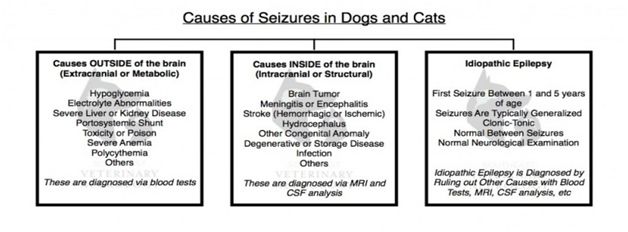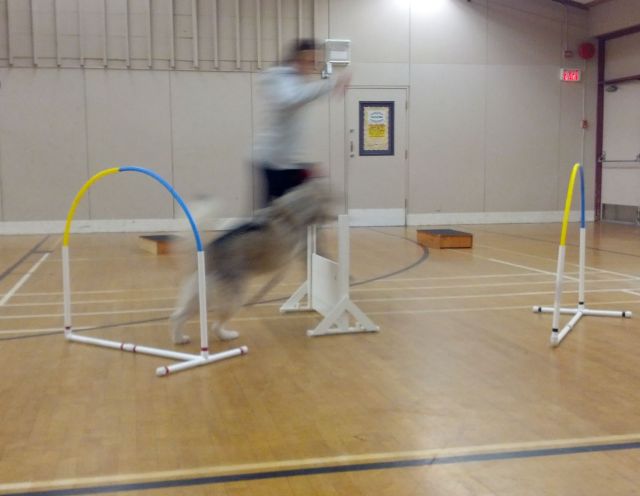Watching your dog go through a seizure is a gut wrenching experience – you feel helpless as there is very little you can do to help. The seizure has to run its course. When Rocco collapsed into his first grand mal, my brain went straight to the worst case scenario: poison! After running extensive blood work at the vet clinic all looked normal. There was always the possibility that the seizure was just a one off incident. We all hoped that would be the case. Sadly, a month later he had another seizure, and then another. He was diagnosed with Idiopathic Epilepsy.
The Facts About Epilepsy
Canine epilepsy is a very broad term referring to seizure disorders. There are many types of epilepsy categorized based on the root cause of the seizures.

Source: SouthEast Veterinary Neurology http://sevneurology.com
In general epilepsy is characterized by reoccurring seizures. Seizures are the result of abnormal electrical activity in the brain, also referred to as an “electrical storm”. Seizures can be divided into generalized (affecting the whole brain) or focal (only affecting a small part of the brain). Generalized seizures are further divided into Grand Mal: a major motor seizure in which the dog usually falls over, loses consciousness and after a Tonic phase during which the animal remains rigid and experiences apnea, a Clonic phase occurs which can include padding of the limbs, trashing of the whole body, head shaking, chewing, biting, drooling and sometimes defecation, or a Petit Mal: very brief in duration, and may express itself as a momentary loss of consciousness, loss of muscle tone, blank expression or staring into distance or confusion. The signs of a Petit Mal usually go unrecognized in a dog.
The frequency and severity of the seizures depends on each individual dog and can rarely be predicted. Both variables can change at any time, and available treatments, even though effective, can never guarantee to fully control the seizures.
Idiopathic Epilepsy (Idiopathic meaning “of unknown cause”) is diagnosed through elimination. After all recommended test are performed and when none of them show an underlying condition, then a diagnosis of idiopathic epilepsy is made. This diagnosis can be verified with an EEG scan that will show abnormal electrical activity in the brain.
The diagnosis is further confirmed if the first seizure has occurred in an individual between 1 to 3 years of age, and if the dog is of a breed known to be prone to this disease. Some of the breeds that have been noted to have a higher incidence of idiopathic epilepsy are: Beagles, Dachshunds, Keeshonden, German Shepherd Dogs, Belgian Tervurens, Cocker Spaniels, Collies, Golden Retrievers, Labrador Retrievers, Irish Setters, Poodles, Miniature Schnauzers, St. Bernards, Siberian Huskies, and Wire Fox Terriers.
The Treatments Available for Epilepsy
There is a variety of drug therapies available. The goal of these therapies is to find a fine balance between minimizing the occurrence and severity of seizures on one hand and minimizing the side effects of anticonvulsant drugs on the other. It is often the case that, even though controlled, seizures are never fully eliminated. The success of the drug therapy is highly dependent on the commitment of the owners, who have to make sure that the drug is administered at exactly the same time, same dose and there are minimal variables in the dog’s lifestyle. The drug therapy can be challenging, as it takes a long time to fine tune the dosage, and sometimes after years of successful treatment the dog may relapse and the seizures can worsen.
There are many holistic approaches to treating idiopathic epilepsy than can be used in conjunction with drug therapy. Some of the treatments that have been successful are: acupuncture, gold bead implants, supplementation with vitamin B6, magnesium and manganese, chiropractic adjustments to relieve pressure on the base of the skull, Reiki; and most recently, the use of medicinal cannabis is showing promising results.
Massage can also be of great help for dogs with seizures bringing them comfort and relaxation. Massage can be used after a seizure to relax and soothe the muscles. Since a Grand Mal seizure is a very traumatic event for the whole body, often leaving the muscles tense, sore, spasming and/or twitching, massage can help to relax the muscles and bring comfort. Often times dogs are confused, anxious or even panicked after a seizure, massage can help with the recovery stage by relaxing and comforting the dog. It can be used on an ongoing basis as a management tool to support homeostasis and the maintenance of normal activity levels, with the added benefit of relaxing and soothing the nervous system.
Even though Canine Epilepsy can be a devastating diagnosis, given the current treatment options and the support network available for pet guardians, it is a manageable condition that in no way prevents dogs from living full and happy lives.
 Three years into his diagnosis Rocco is still pursuing his career as a massage demo dog, and happily partakes in agility and sheep herding. His passions are long road trips, running, swimming and hunting squirrels.
Three years into his diagnosis Rocco is still pursuing his career as a massage demo dog, and happily partakes in agility and sheep herding. His passions are long road trips, running, swimming and hunting squirrels.
SouthEast Veterinary Neurology http://sevneurology.com
Canine Epilepsy http://www.canineepilepsy.co.uk/
Canine Epilepsy Network http://www.canine-epilepsy.net/
Canine Epilepsy Resource Center http://www.canine-epilepsy.com/







Excellent post! As a fellow Epi-Husky Mom and Canine Epilepsy advocate, I’ll be sharing this post on my FiveSibes Facebook page. Hugs to beautiful Rocco!
Thank you, Dorothy!